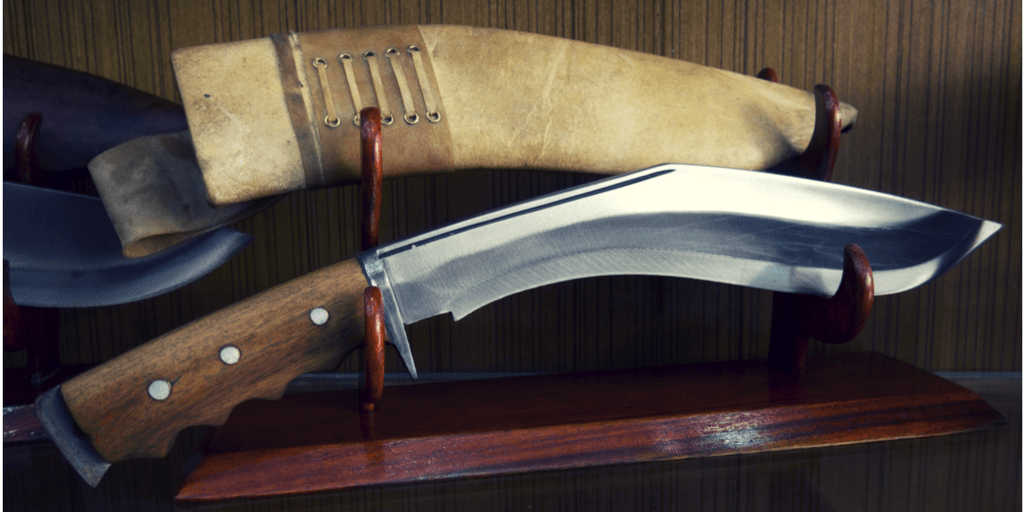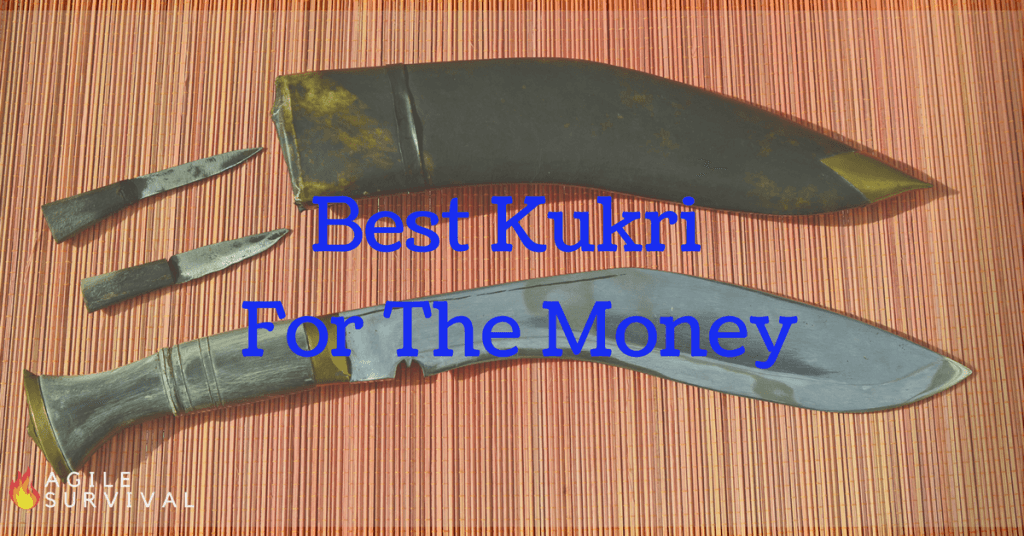Our top pick for the best kukri machete for the money is the Ka-Bar Kukri.
About 2,500 years ago the first kukri were created in Nepal. Based on its resemblance to a Greek sword, called Machira, we trace its origins to the powerful Nepalese dynasty of Malla in the 13th century.
Despite its long history, the Kukri wasn't used in military combat until 1814. The method of use of the kukri was filed by the British who saw this weapon as they fought against the Nepalese.
So, kukri have been used for a long time. Today you have tons of options. You can go with a razor sharp, genuine gurkha kukri to cheap machetes with nylon sheaths. Without further ado, let's dig in...
Kukri Buying Guide: How to Choose
Kukri machetes are often used by hunters as defense weapons. They can also be very inexpensive and useful for outdoor adventures.
If you plan to use your kukri for hunting or defense, find one with a spring carbon steel blade. To keep your weapon’s weight light, find a knife with three fullers.
The blade length will depend on what you plan to hunt or defend against. Shorter blades - twelve inches or less - are faster. Go with the shorter blade if you need speed over force. As blade length grows, you sacrifice speed for force.
As with anything, know how you plan to use your kukri machete for before buying. It will narrow your options and help guide you to the top kukri machetes available.
Kukri Buying Guide: Strengths and Advantages
You can even for use it to dig a hole in your garden.
It is a sharp tool that doesn't take up a lot of room when you carry it, or when you store it. A well taken care of kukri, will be a dependable, reliable tool for years to come.
Kukri Buying Guide: Features to Look For
The most important features to look for when buying a kurki are the sheath, handle, blade shape and blade material.
Sheath
You can't carry your machete in your bare hand all the time. You need a good sheath. It will keep your kukri secure and protected while on the move. The sheath needs to be the right size for your kukri (you would think this would be obvious), and needs to hold the blade tightly and securely in place. A leather or nylon sheath is fine, as long as its high quality.
Handle
The handle of the kukri will determine your grip and stability. Traditional kukri handles are made of rubber and wood. Modern models use Micarta and G10 materials and have a lanyard hole. They are more popular today.
Before you buy, you need to see how well the kukri fits in your hand, and whether it feels slips or not. Try this test: wet the grip before you hold it and see if it is still secure and comfortable.

Blade Shape
The blade shape has a specific purpose. Kukris come in various shapes of blades. Knowing whether you plan to skin, slice or chop, will determine which kind of blade to get. Gardeners may even want to use the kukri for digging.
The various shapes of blades including:
- Clip point
- Sheep’s foot
- Tanto
- Dagger point
- Spear point
- Drop point
- Kukri recurred style
A kukri with a clip or drop point is perfect for hunters, while those who use it for chopping or bush craft should find a kukri with a blade shaped like a machete.
Material
As for the material for the blade, stainless steel is a great option. It is inexpensive and rust-resistant. So, it quickly loses its sharpness and is not as durable.
You get a higher degree of sharpness with carbon steel, which may be pricier but worth the cost.
As always, consider what you plan to use your knife for. People into bushcraft or camping will need a blade made of carbon steel.
Kukri Buying Guide: Maintenance
You need to maintain your kukri knife to enjoy it long-term. First, use gun or machine oil for cleaning the blade of the knife. Do not leave marks of fingerprints while cleaning. Do this every thirty days.
Clean a rusty blade with rust remover or gasoline and fine-grain sandpaper. You can also buy cleaning agents specially designed to keep your knife in great, shining condition.
Polish the silver and brass casings and fittings on the sheath along with the blade itself.
Do not wet your knife and if you do, dry it as soon as possible. Keep your knife in a cool, dry place away from extreme temperatures.
Don't expose your leather sheath to the outdoor elements for extended periods of time. It will cause the leather to shrink, and you kukri will no longer fit securly.
Scrub the handle of the knife with a hard brush (especially if it has carvings on it). Get as much of the dirt and grit out to maintain its hygiene and quality.
Do not use the blade on stones or metallic surfaces.
Best Kukri Machete 2019
For heavy duty cutting without having to break the bank, pick this kukri. It is the “workhorse” of the bunch.
The Cold Steel Kukri comes in two sizes: thirteen and seventeen inches long. Remember, the longer blade sacrifices agility for strength.
Both options are sharp enough for cutting through the forest’s most robust wood, and come with a 5 inch long polypropylene handle.
It weighs sixteen-ounce and comes with a Cordura sheath. In fact, you can think of it as both a machete and a hatchet at the same time. The Cold Steel Kukri Machete is a great tool for bushcraft in alpine environments as well as the tropics.
The knife has a matte, anti-rust finish that to make it durable and long-lasting. You will never attract unwanted attention - the black coating on the blade keeps glare at bay.
Clearing thin vines in the jungle is a total breeze with this knife.
People who want a longer, lighter blade will love the OKC. It is light and sturdy at the same time - a rare combination.
It weighs in at eighteen ounces, and its 11.5 inch blade is black-coated for no glare. Its shock absorbing handle makes it the perfect alternative to other large knives - like the Bowie.
The OKC Knife is perfect for hunting. Its light weight won't slow you down. This knife is so light you can use it hour after hour without getting drained.
It's perfect for for an afternoon spent chopping and cutting your way through the wilderness.
This Kukri is deadly quick with its shorter-length blade. You can rely on it one hundred percent of the time.
This Kukri is deadly quick with its shorter-length blade. You can rely on it one hundred percent of the time.
Ka-Bar's Kukri 2-1249-9 is an affordable option for chopping down branches for firewood. Or, cutting through thick brush.
At 17 inches over 27 ounces it's big and heavy. Along with all that weight comes power. Power you can use to hack though pretty much anything you find out in the wilderness.
It's built tough too. The black-coated, carbon steel blade was designed for durability. Even the harshest conditions are no match for this knife. And, the blade’s black coating ensures that sunlight won’t blind your eyes, as you slice your way through the woods.
Ka-bar's grooved grip, Kraton G handle gives you complete control as you move. In fact, rather than buying a smaller sized ax, you might want to consider this knife.
The Ka-Bar kukri machete's great quality and low cost make it an awesome value.
I think I'm in love with Condor's heavy duty kukri. It's made of 1075 high carbon steel. So it's edge gets sharp and stays sharp.
Plus the hardwood handle is sexy (yes, I just called the handle of a machete sexy). The wood handle is well designed with a comfortable grip. It will take everything you can dish out.
Definitely shortest of the group at only 10-inches, and it weighs in at 16 ounces. You can still use it as a tree hatchet to cut down branches up to an inch in thick without blinking. It can also substitute for an axe - quickly chopping through logs up to 6-inches thick.
Tip: Use an orbital sander to keep it sharp.
The forest’s toughest wood will be a breeze to cut through with this kukri knife.
This is an authentic gurkha kukri. It's the same knife issued to the British Gurkhas in Afghanistan.
It is sixteen inches of high-grade carbon steel (overall length). The Rosewood handle and the razor sharp blade can slash through two inches of thick wood from the forest.
If you need to topple some smaller trees, this sharp knife is the one to use. At 28 ounces, it makes a great ax-substitute. It's also efficient, thanks to its perfect symmetrical shape.
The Gurkha Aeof Kukri comes with a natural brown leather sheath. Plus, it comes with a chakmak and karda - two smaller blades that fit inside the sheath. These are maintenance tools. The chakmak is an edgeless tool used to keep the khukuri's blade sharp (but doesn't replace a proper sharpener). The karda performs more delicate tasks ill-suited for the kukri, like skinning and carving.
So if you are searching for a genuine, well-crafted kukri, buy this one. It is hand crafted by the blacksmiths of Biswakarma, who also build knives for the Gurka indigenous soldiers of Nepal.
Conclusion
Kukri knives have been associated with adventure, valor, and bravery throughout history. These days, it's a great tool for hunting, in a camper’s kit or for adventure enthusiasts.
Dollar for dollar, Kukris are a great machete for the money. You get a great tool without breaking the bank or burning a hole in your pocket.






